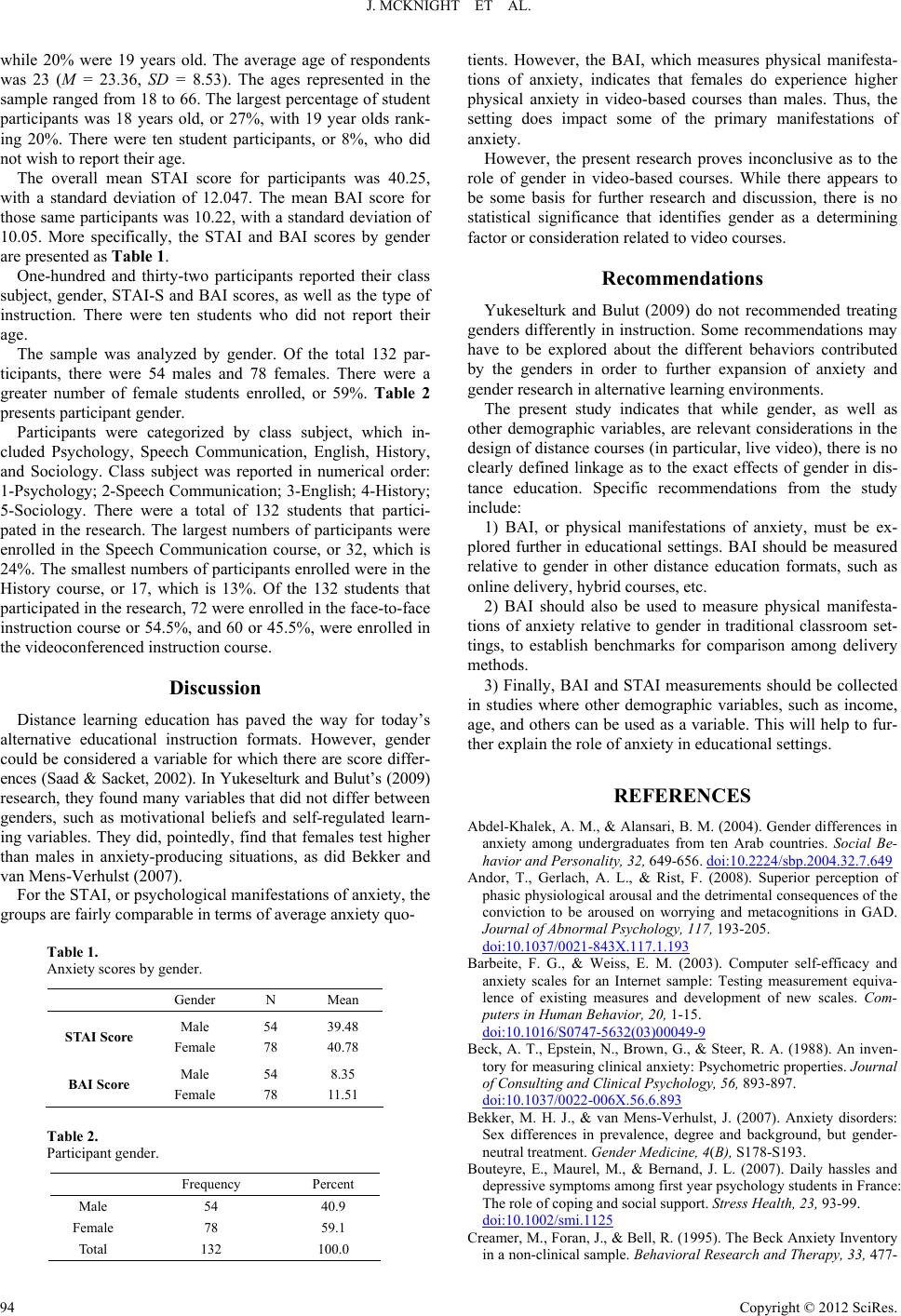
J. MCKNIGHT ET AL.
while 20% were 19 years old. The average age of respondents
was 23 (M = 23.36, SD = 8.53). The ages represented in the
sample ranged from 18 to 66. The largest percentage of student
participants was 18 years old, or 27%, with 19 year olds rank-
ing 20%. There were ten student participants, or 8%, who did
not wish to report their age.
The overall mean STAI score for participants was 40.25,
with a standard deviation of 12.047. The mean BAI score for
those same participants was 10.22, with a standard deviation of
10.05. More specifically, the STAI and BAI scores by gender
are presented as Table 1.
One-hundred and thirty-two participants reported their class
subject, gender, STAI-S and BAI scores, as well as the type of
instruction. There were ten students who did not report their
age.
The sample was analyzed by gender. Of the total 132 par-
ticipants, there were 54 males and 78 females. There were a
greater number of female students enrolled, or 59%. Table 2
presents participant gender.
Participants were categorized by class subject, which in-
cluded Psychology, Speech Communication, English, History,
and Sociology. Class subject was reported in numerical order:
1-Psychology; 2-Speech Communication; 3-English; 4-History;
5-Sociology. There were a total of 132 students that partici-
pated in the research. The largest numbers of participants were
enrolled in the Speech Communication course, or 32, which is
24%. The smallest numbers of participants enrolled were in the
History course, or 17, which is 13%. Of the 132 students that
participated in the research, 72 were enrolled in the face-to-face
instruction course or 54.5%, and 60 or 45.5%, were enrolled in
the videoconferenced instruction course.
Discussion
Distance learning education has paved the way for today’s
alternative educational instruction formats. However, gender
could be considered a variable for which there are score differ-
ences (Saad & Sacket, 2002). In Yuke selturk and Bulut’s (2009)
research, they found many variables that did not differ between
genders, such as motivational beliefs and self-regulated learn-
ing variables. They did, pointedly, find that females test higher
than males in anxiety-producing situations, as did Bekker and
van Mens-Verhulst (2007).
For the STAI, or psychological manifestations of anxiety, the
groups are fairly comparable in terms of average anxiety quo-
Table 1.
Anxiety scores by gender.
Gender N Mean
STAI Score Male
Female
54
78
39.48
40.78
BAI Score Male
Female
54
78
8.35
11.51
Table 2.
Participant gender.
Frequency Percent
Male 54 40.9
Female 78 59.1
Total 132 100.0
tients. However, the BAI, which measures physical manifesta-
tions of anxiety, indicates that females do experience higher
physical anxiety in video-based courses than males. Thus, the
setting does impact some of the primary manifestations of
anxiety.
However, the present research proves inconclusive as to the
role of gender in video-based courses. While there appears to
be some basis for further research and discussion, there is no
statistical significance that identifies gender as a determining
factor or consideration related to vid eo cou rses.
Recommendations
Yukeselturk and Bulut (2009) do not recommended treating
genders differently in instruction. Some recommendations may
have to be explored about the different behaviors contributed
by the genders in order to further expansion of anxiety and
gender research in alternative learning environments.
The present study indicates that while gender, as well as
other demographic variables, are relevant considerations in the
design of distance courses (in particular, live video), there is no
clearly defined linkage as to the exact effects of gender in dis-
tance education. Specific recommendations from the study
include:
1) BAI, or physical manifestations of anxiety, must be ex-
plored further in educational settings. BAI should be measured
relative to gender in other distance education formats, such as
online delivery, hybrid courses, etc.
2) BAI should also be used to measure physical manifesta-
tions of anxiety relative to gender in traditional classroom set-
tings, to establish benchmarks for comparison among delivery
methods.
3) Finally, BAI and STAI measurements should be collected
in studies where other demographic variables, such as income,
age, and others can be used as a variable. This will help to fur-
ther explain the role of anxiety in educational set tings.
REFERENCES
Abdel-Khalek, A. M., & Alansari, B. M. (2004). Gender differences in
anxiety among undergraduates from ten Arab countries. Social Be-
havior and Personality, 32, 649-656. doi:10.2224/sbp.2004.32.7.649
Andor, T., Gerlach, A. L., & Rist, F. (2008). Superior perception of
phasic physiological arousal and the detrimental consequences of the
conviction to be aroused on worrying and metacognitions in GAD.
Journal of Abnormal Psycholo gy , 117, 193-205.
doi:10.1037/0021-843X.117.1.193
Barbeite, F. G., & Weiss, E. M. (2003). Computer self-efficacy and
anxiety scales for an Internet sample: Testing measurement equiva-
lence of existing measures and development of new scales. Com-
puters in Human Behavior, 20, 1-15.
doi:10.1016/S0747-5632(03)00049-9
Beck, A. T., Epstein, N., Brown, G., & Steer, R. A. (1988). An inven-
tory for measuring clinical anxiety: Psychometric properties. Journal
of Consulting and Clinical Psychology , 56, 893-897.
doi:10.1037/0022-006X.56.6.893
Bekker, M. H. J., & van Mens-Verhulst, J. (2007). Anxiety disorders:
Sex differences in prevalence, degree and background, but gender-
neutral treatment. Gender Medicine, 4(B), S178-S193.
Bouteyre, E., Maurel, M., & Bernand, J. L. (2007). Daily hassles and
depressive symptoms among first year psychology students in France:
The role of coping and social suppo rt. Stress H e a lth, 23, 93-99.
doi:10.1002/smi.1125
Creamer, M., Foran, J., & Bell, R. (1995). The Beck Anxiety Inventory
in a non-clinical sample. Behavioral Research and Therapy, 33, 477-
Copyright © 2012 SciRes.
94